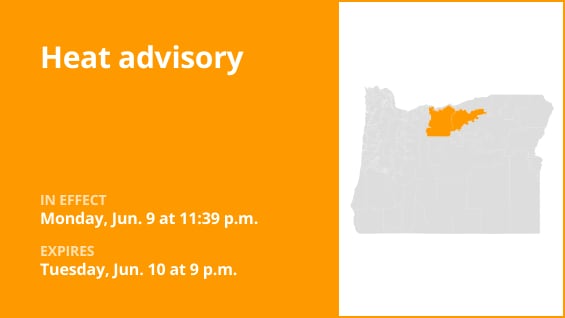On Monday at 11:39 p.m. an updated heat advisory was issued by the National Weather Service in effect until Tuesday at 9 p.m. for Foothills of the Southern Blue Mountains of Oregon and North Central Oregon.
The weather service states, “Hot conditions with high temperatures between 90 – 100 degrees expected with overnight lows 60 – 70 degrees. This will pose a moderate to locally major risk of heat-related illness.”
“Hot temperatures may cause heat illnesses. Heat will significantly increase the risk of heat-related illnesses for those who are sensitive to heat, especially those without effective cooling or adequate hydration,” explains the weather service.
Mastering the heat: Guidelines for staying safe in high temperatures
-
Stay hydrated:
Keep yourself well-hydrated by drinking plenty of fluids. -
Find cool shelter:
Stay in an air-conditioned room. -
Avoid sun exposure:
Stay out of the sun, and check up on relatives and neighbors. -
Child and pet safety:
Do not leave young children and pets unattended in vehicles when car interiors can reach lethal temperatures in a matter of minutes. -
Caution outdoors:
When working or spending time outside, take extra precautions. -
Select the ideal time:
If possible, move strenuous activities to early morning or evening for more favorable conditions. -
Recognize heat-related issues:
Know how to recognize the signs and symptoms of heat exhaustion and heat stroke. -
Stay cool with clothing:
Select lightweight and loose-fitting outfits for enhanced comfort.
Additional tips for outdoor workers:
- The Occupational Safety and Health Administration (OSHA) recommends frequent rest breaks in shaded or air-conditioned areas for outdoor workers.
- If someone is overwhelmed by the heat, swiftly relocate them to a cool, shaded location.
- In emergency situations, dial 911 for immediate assistance.
These NWS heat safety recommendations are vital for your well-being during periods of high temperatures. Stay informed and take the necessary steps to protect yourself and others from the heat’s potentially dangerous effects.
Advance Local Weather Alerts is a service provided by United Robots, which uses machine learning to compile the latest data from the National Weather Service.
Mastering the heat: Guidelines for staying safe in high temperatures
-
Stay hydrated:
Keep yourself well-hydrated by drinking plenty of fluids.
-
Find cool shelter:
Stay in an air-conditioned room.
-
Avoid sun exposure:
Stay out of the sun, and check up on relatives and neighbors.
-
Child and pet safety:
Do not leave young children and pets unattended in vehicles when car interiors can reach lethal temperatures in a matter of minutes.
-
Caution outdoors:
When working or spending time outside, take extra precautions.
-
Select the ideal time:
If possible, move strenuous activities to early morning or evening for more favorable conditions.
-
Recognize heat-related issues:
Know how to recognize the signs and symptoms of heat exhaustion and heat stroke.
-
Stay cool with clothing:
Select lightweight and loose-fitting outfits for enhanced comfort.
Additional tips for outdoor workers:
-
The Occupational Safety and Health Administration (OSHA) recommends frequent rest breaks in shaded or air-conditioned areas for outdoor workers.
-
If someone is overwhelmed by the heat, swiftly relocate them to a cool, shaded location.
-
In emergency situations, dial 911 for immediate assistance.
These NWS heat safety recommendations are vital for your well-being during periods of high temperatures. Stay informed and take the necessary steps to protect yourself and others from the heat’s potentially dangerous effects.
Advance Local Weather Alerts is a service provided by United Robots, which uses machine learning to compile the latest data from the National Weather Service.





More Stories
Update: Heat advisory affecting Foothills of the Southern Blue Mountains of Oregon and North Central Oregon
Update: Heat advisory affecting Foothills of the Southern Blue Mountains of Oregon and North Central Oregon
Update: Heat advisory affecting Foothills of the Southern Blue Mountains of Oregon and North Central Oregon